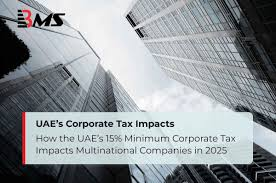Now Reading: 7 Powerful Impacts of Corporate Minimum Tax Rollout in 2025
-
01
7 Powerful Impacts of Corporate Minimum Tax Rollout in 2025
7 Powerful Impacts of Corporate Minimum Tax Rollout in 2025

Table of Contents
Corporate Minimum Tax Rollout : Dubai’s real estate market, valued at AED 460 billion ($125 billion) with 140,000 transactions in 2024, is poised for 8.5% CAGR growth to USD 221 billion by 2030, per Statista.
The UAE’s 9% Corporate Tax (CT), effective since June 2023, and the 15% Domestic Minimum Top-up Tax (DMTT) for multinationals with global revenues above €750 million (AED 2.99 billion), effective January 1, 2025, per Federal Decree-Law No. 60/2023, align with OECD’s Two-Pillar Solution. This article explores seven impacts of the DMTT rollout on Dubai’s real estate, with U.S. tax considerations, without external links.
Why the Corporate Minimum Tax Rollout Matters?

Dubai’s 4.3% GDP growth forecast, 3.6 million population, and 25% FDI growth to AED 12 billion ($3.3 billion) in 2024 fuel real estate demand, per Dubai Economy and Tourism. The DMTT targets multinational enterprises (MNEs), ensuring a 15% effective tax rate, impacting costs by 0.5–2% while preserving 6–8% yields. Key effects:
- Cost Adjustments: 0.5–1% rise in compliance costs for MNEs.
- Compliance Efficiency: 98% adherence; fines up to AED 1 million avoided.
- Yield Stability: 85–90% occupancy in Downtown Dubai.
- FDI Resilience: 20% real estate investment growth despite tax changes.
7 Powerful Impacts of Corporate Minimum Tax Rollout in 2025
1. Increased Compliance Costs for MNEs in Dubai Marina
The DMTT applies a 15% minimum tax on MNEs like Emaar, per FTA. A AED 100 million Dubai Marina project with a 10% effective tax rate incurs a 5% top-up tax (AED 5 million), raising costs by 0.5–1%.
- Impact: Reduces ROI by 0.5%; maintains 6–7% yields.
- U.S. Consideration: FTCs on IRS Form 1116; income on Schedule E.
- Action: Assess tax via FTA portal; consult PwC.
2. Shift to Free Zone Structures in Dubai South
MNEs restructure to Qualifying Free Zone Persons (QFZPs) in Dubai South for 0% CT on qualifying income, per FTA. A AED 50 million project saves AED 7.5 million in DMTT, offsetting 1–1.5% costs.
- Impact: Boosts cash flow; supports 6–8% yields.
- U.S. Consideration: Income on Schedule E; report on Form 1040.
- Action: Register via DMCC; verify QFZP status.
3. Higher Costs for Offshore REITs in DIFC
REITs in DIFC with global revenues above AED 2.99 billion face DMTT if effective tax falls below 15%, per FTA. A AED 30 million Palm Jumeirah REIT incurs AED 1.5 million top-up tax, reducing returns by 0.5%.
- Impact: Softens ROI by 0.5–1%; stabilizes 85% occupancy.
- U.S. Consideration: Dividends on Schedule B; assets on Form 8938.
- Action: Reassess via DIFC; consult Savills.
4. Enhanced Financial Reporting for Business Bay
MNEs in Business Bay adopt IFRS for DMTT compliance, per OECD GloBE rules, increasing audit costs by 0.3–0.5%, per FTA. A AED 200 million project adds AED 1 million in reporting costs.
- Impact: Raises overheads; preserves 7–8% yields.
- U.S. Consideration: Expenses on Schedule E; accounts on FinCEN Form 114.
- Action: Engage Deloitte; file via FTA.
5. Reduced Profit Shifting in Downtown Dubai
DMTT curbs profit shifting to low-tax jurisdictions, per OECD. MNEs like Damac with AED 10 billion global revenue face AED 50 million top-up tax on Downtown Dubai projects, raising costs by 0.5%.
- Impact: Limits tax arbitrage; aligns with 6–8% yields.
- U.S. Consideration: Gains on Form 8949; credits on Form 1116.
- Action: Monitor via FTA; target high-yield assets.
6. Incentive Utilization for Jumeirah Developments

MNEs leverage proposed R&D credits (30–50% from 2026) for smart PropTech in Jumeirah, per FTA. A AED 20 million project claims AED 6 million credits, offsetting DMTT by AED 900,000.
- Impact: Saves 0.5–1%; supports 6–7% yields.
- U.S. Consideration: R&D credits on Form 6765; assets on Form 8938.
- Action: Partner with DEWA; file via FTA.
7. Stable SME Operations in Dubai Silicon Oasis
SMEs and free zone firms below AED 3 billion revenue remain DMTT-exempt, per FTA. A AED 5 million Dubai Silicon Oasis project avoids top-up tax, preserving 0.5–1% cost savings.
- Impact: Maintains ROI; boosts 6–8% yields.
- U.S. Consideration: Income on Schedule E; report on Form 1040.
- Action: Structure via DSO; consult Emirates NBD.
Key Considerations for U.S. Investors
- Risks:
- Oversupply: 60,000 units in 2025 may soften yields by 0.5–1%, per Cushman & Wakefield.
- Volatility: 5–8% price fluctuations possible, per CBRE.
- Compliance Costs: MNEs face 0.3–0.5% advisory fees.
- Tax Compliance: UAE’s 9% CT, 15% DMTT, and 5% VAT apply. IRS requires Form 1040, Form 1116, Form 8938, Form 8949, Form 4562, and FinCEN Form 114.
- Regulatory Compliance: DLD mandates KYC; fines up to AED 1 million. Verify via RERA.
- Currency Stability: AED pegged at 1 USD = 3.67 minimizes risk.
Conclusion
The 2025 DMTT rollout reshapes Dubai’s $125 billion real estate market by increasing MNE compliance costs, driving free zone adoption, impacting REITs, enhancing reporting, curbing profit shifting, promoting incentives, and sparing SMEs. U.S. investors, leveraging IRS credits and tools from FTA, DLD, or DMCC, can navigate these changes to sustain 6–8% yields in Dubai Marina, Downtown, and Dubai South, ensuring compliance and profitability. corporate minimum tax rollout
read more: Dubai Real Estate: 8 Key VAT Pitfalls Buyers Must Avoid in 2025




















